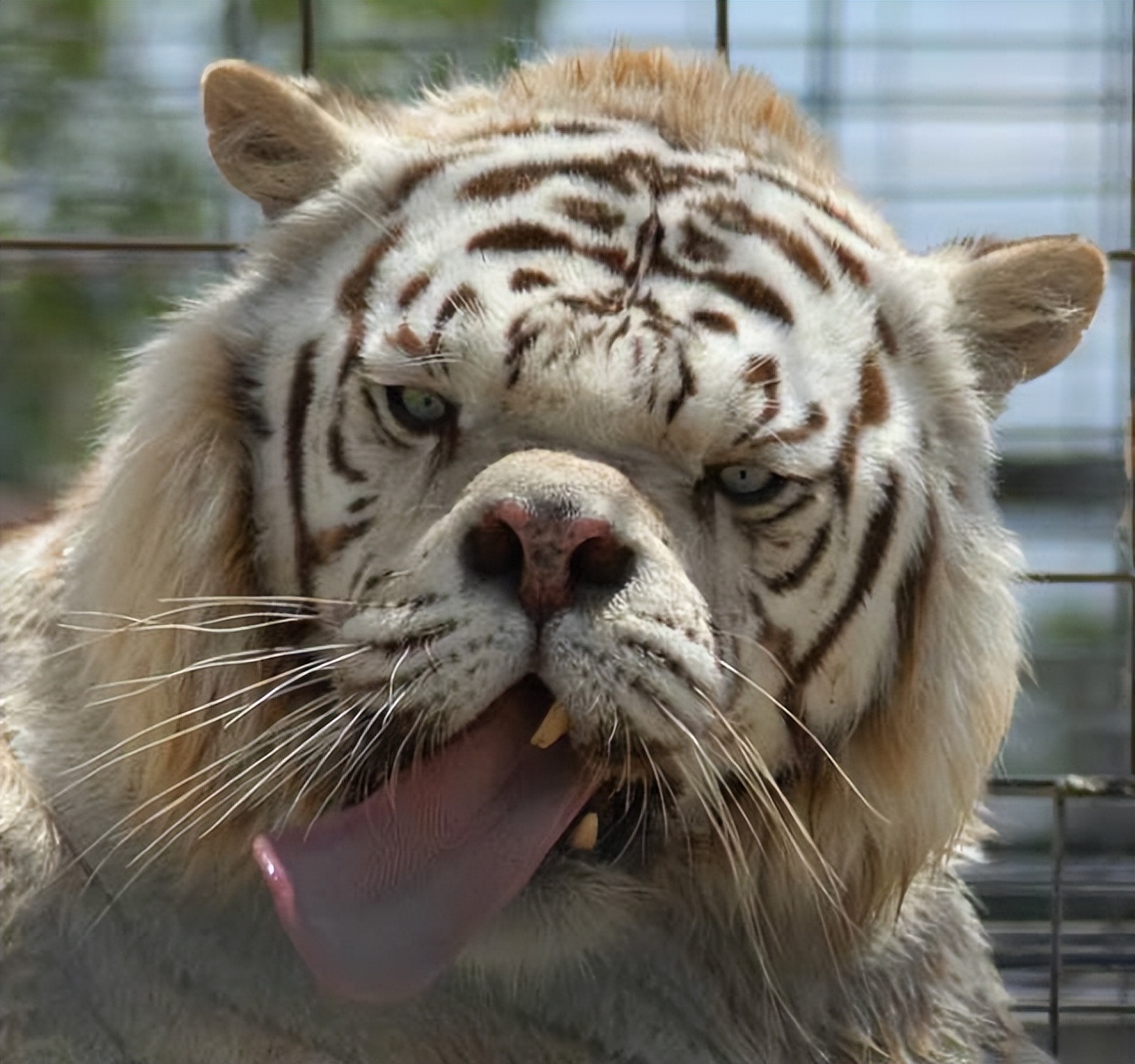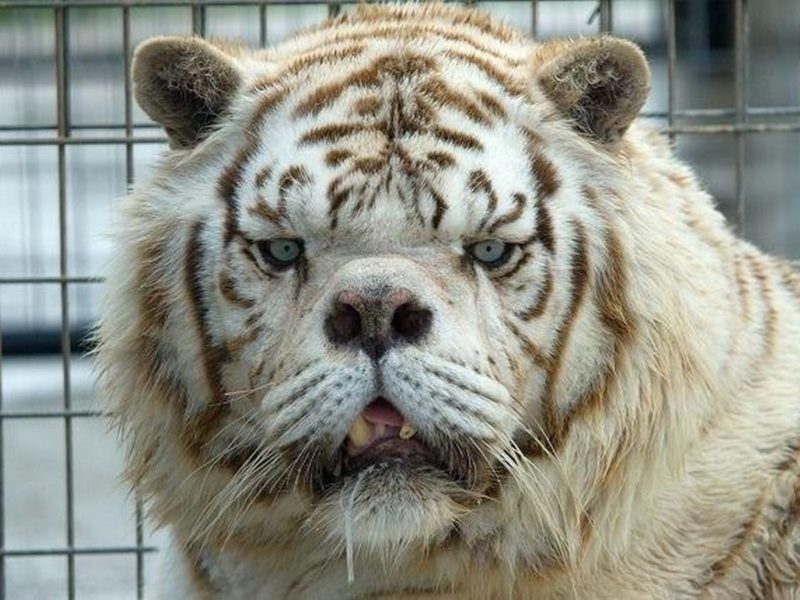Have you ever stopped to think about animals, especially those grand, wild cats like tigers, and whether they might experience something similar to conditions we see in people? It’s a very interesting thought, so it is. People sometimes wonder about a tiger with Down syndrome, and that curiosity comes from a good place, wanting to understand more about the lives of these powerful creatures.
When we talk about Down syndrome in humans, we’re referring to a specific genetic situation, where there’s an extra full or partial copy of chromosome 21. This extra bit of genetic material brings about a unique set of physical traits and developmental patterns. But what about animals? Do they have chromosomes like ours? Can their genetic makeup get mixed up in ways that look a bit like what we see in humans? That’s a pretty big question, and one that makes you think, you know?
This article aims to look at the science behind such a thought. We will explore how genetics work in big cats, what kinds of genetic variations animals can have, and what this might mean for an animal as magnificent as a tiger. It’s a chance to learn more about the incredible diversity of life on our planet and the ways all living things are connected, yet very, very different, too.
Table of Contents
- The Tiger: A True Giant of the Wild
- Understanding Down Syndrome in Humans and Its Animal Parallels
- Can a Tiger Truly Have Down Syndrome?
- The Challenges for a Wild Tiger with a Genetic Difference
- Public Perception and the Media Spotlight
- What We Can Learn from These Discussions
- Frequently Asked Questions About Tigers and Genetic Conditions
The Tiger: A True Giant of the Wild
Tigers, scientifically known as Panthera tigris, are quite simply among the most recognizable and popular of the world's charismatic megafauna. They are, you know, the largest living cat species, with a powerful, muscular body that has a large head and paws, along with a long tail and striking orange fur. A royal Bengal tiger, for instance, often makes its home in places like the Sundarban mangrove forests, where it’s a truly impressive sight. These animals are powerful hunters with sharp teeth, very strong jaws, and agile bodies, ranging across Asia from Russia all the way to Sumatra, too.
Their diet, as you might guess, is all about meat. A royal Bengal tiger living in the Sundarban mangrove forests feeds primarily upon a couple of herbivores, you know. These include the axis deer and the wild boar. In fact, the predominant natural food of the royal Bengal tiger is the axis deer and the Bengal bush boar, both of which are found by the hundreds of thousands all over the place. Some might even prefer sambhur deer as a first choice, then cheetal deer, and wild boars as a third preference, which is interesting, isn't it?
These big cats are apex predators, meaning they sit right at the top of their food chain, with nothing naturally hunting them. Their distinctive fur is orange and white with dark vertical stripes, and the pattern of stripes is unique to each individual, just like human fingerprints. A big cat's tail is usually about three feet long, and on average, one of these magnificent animals weighs about 450 pounds. They are, in a way, the planet's most charismatic species, and their presence in the wild is truly something special to see, if you ever get the chance.
Understanding Down Syndrome in Humans and Its Animal Parallels
Down syndrome in people happens when there is an extra copy of chromosome 21, or sometimes a part of it. This extra genetic material changes how the body and brain develop, leading to certain physical characteristics and learning differences. It’s a genetic condition that has been well studied in humans, and we have a pretty good grasp of what it means for someone, you know.
When we start to think about animals, things get a little different. While animals can and do have genetic variations and chromosomal abnormalities, the specific condition of Down syndrome, as we understand it in humans, isn't typically found in them. This is because different species have different numbers of chromosomes and different genetic structures. For example, humans have 23 pairs of chromosomes, while a tiger has 19 pairs. So, an extra chromosome 21, which causes Down syndrome in humans, just isn't something that can happen in a tiger, more or less, because they don't have a chromosome 21 in the same way we do.
However, animals can show physical traits or developmental delays that might remind us of Down syndrome in humans. These could be things like unusual facial features, developmental challenges, or certain health issues. Such traits would be due to other genetic mutations or chromosomal changes unique to that animal's species. So, while you might see an animal that looks a bit different, it's important to remember that it's not the same condition as Down syndrome in people, you know, not scientifically speaking. It's a different kind of genetic variation altogether, perhaps.
Can a Tiger Truly Have Down Syndrome?
The short answer, from a scientific standpoint, is no, a tiger cannot truly have Down syndrome in the way a human does. As mentioned, Down syndrome is linked to an extra chromosome 21 in humans. Tigers, like all other species, have their own unique set of chromosomes. Their genetic blueprint is just different. So, a tiger can't have an extra chromosome 21 because that specific chromosome number simply doesn't exist in their genetic makeup, which is pretty clear, actually.
What can happen, though, is that a tiger might be born with other types of genetic abnormalities or chromosomal variations. These could lead to physical differences, perhaps a slightly altered facial appearance, or maybe some developmental challenges. Such conditions are rare in the wild, but they do occur across many animal species. These variations are often unique to the individual animal or its species and are not the same as Down syndrome, even if some outward signs might appear similar to the untrained eye, more or less.
Sometimes, photos of animals with unusual appearances circulate online, and people might mistakenly label them as having "Down syndrome." This usually comes from a place of genuine curiosity and a desire to understand, but it's not accurate scientifically. These animals might have a different genetic condition, or perhaps a developmental issue that occurred during their growth. The key thing to remember is that while genetic conditions exist in all living things, the specific one we call Down syndrome is a human condition, and that’s just how it is.
The Challenges for a Wild Tiger with a Genetic Difference
Imagine a tiger born with any sort of genetic difference that affects its physical abilities or its senses. A royal Bengal tiger, a powerful hunter, relies completely on its strength, its keen eyesight, and its very sharp hearing to survive in places like the Sundarban mangrove forests. It needs to be incredibly agile to catch its main food sources, like axis deer and wild boar. Any condition that makes it harder to run, see, or hear would be a huge disadvantage, you know, a really big one.
For a wild tiger, life is tough. They are apex predators, yes, but they still have to work incredibly hard to find food and stay safe. A tiger with any kind of physical or developmental challenge would likely struggle to hunt effectively. It might find it difficult to stalk prey, to make a swift kill, or even to compete with other tigers for territory and mates. This would make its chances of survival in the wild very, very slim, perhaps even impossible, as a matter of fact.
In a natural setting, animals with significant genetic conditions often don't survive for very long. Natural selection tends to remove individuals who are not well-equipped to thrive in their environment. This is just a part of how wild populations stay strong and healthy over generations. So, while the idea of a tiger with a genetic difference might pull at our heartstrings, the reality of wild life is quite harsh for such an animal, too. It’s a tough truth, but one that shows the incredible adaptations wild animals need to possess, basically.
Public Perception and the Media Spotlight
When an unusual animal appears, especially one with a striking appearance that seems to suggest a condition like Down syndrome, it often captures a lot of public attention. People are naturally drawn to unique stories and creatures that seem a bit different. This can lead to photos and videos spreading very quickly online, often with captions that use terms like "tiger with Down syndrome," even if it's not scientifically accurate, you know, that happens a lot.
This kind of public interest, while well-meaning, can sometimes lead to misunderstandings about animal biology and genetics. It highlights how much more we can all learn about the incredible diversity of life and the specific ways different species are built. It also shows how our human tendency to compare things to ourselves can sometimes lead to misinterpretations when it comes to the animal kingdom, more or less. We see a familiar pattern, and we try to fit it into our own experiences, which is understandable, anyway.
The media, too, plays a part in this. A photo of a highly unusual visitor to SW Alaska, perhaps a Siberian tiger caught on a game camera, can become a big story. If that animal has an unusual appearance, the story can take on a life of its own. It's a chance for people to connect with wildlife, but it also means there's a responsibility to share accurate information. Understanding the true nature of genetic conditions in animals helps us appreciate them for what they are, rather than through a human-centric lens, you know.
What We Can Learn from These Discussions
Talking about whether a tiger can have Down syndrome, or any other genetic condition, helps us learn a lot about biology, about animals, and even about ourselves. It reminds us that while we share a planet with countless species, each one has its own unique genetic blueprint and its own way of living. Tigers, for example, are large, carnivorous mammals, the largest living big cat, with powerful bodies and unique stripe patterns. Their existence is a testament to millions of years of very precise evolution, you know.
It also encourages us to think about conservation. Tigers, scientifically known as Panthera tigris, have striking orange coats, black stripes, and piercing eyes, but like other big cats, they are at risk. The critically endangered Siberian tiger, for instance, faces many threats in the wild. Discussions about genetic health, even hypothetical ones, can make us more aware of the overall well-being of these animals and the challenges they face, from habitat loss to human population density in areas where they live, like the Bengal tiger in Bangladesh and India, which is quite concerning, actually.
By understanding that Down syndrome is a specific human condition, and that animals have their own types of genetic variations, we gain a clearer picture of the natural world. It helps us appreciate the complexity and fragility of life. So, while a "tiger with Down syndrome" isn't a scientific reality, the curiosity it sparks can lead to a deeper appreciation for the wonders of wildlife and the importance of protecting these magnificent creatures for generations to come. You can learn more about tiger conservation efforts on our site, and link to this page for more information on animal genetics.
Frequently Asked Questions About Tigers and Genetic Conditions
Can animals, especially big cats, be born with Down syndrome?
No, animals cannot be born with Down syndrome in the same way humans are. Down syndrome is caused by an extra copy of chromosome 21, which is specific to human genetic makeup. Different animal species have different numbers and types of chromosomes. So, while animals can have other genetic abnormalities, it's not the specific condition known as Down syndrome, you know, that's a human thing.
What are the signs of a genetic condition in a tiger?
Signs of a genetic condition in a tiger could vary widely, depending on what the specific condition is. They might include unusual physical traits, such as an altered facial appearance, or perhaps differences in their body structure. Developmental delays, problems with coordination, or difficulties with senses like sight or hearing could also be indicators. These signs might make it harder for the tiger to survive in its natural environment, which is a big deal, basically.
How do genetic conditions impact the survival of wild animals?
Genetic conditions can have a very significant impact on the survival of wild animals. For an apex predator like a tiger, being able to hunt, move quickly, and sense its surroundings is absolutely vital. Any condition that lessens these abilities makes it much harder to find food, avoid danger, and reproduce. In the wild, animals with such challenges often have a lower chance of living a long life or passing on their genes, which is just how nature works, you know.



Detail Author:
- Name : Lorna Zemlak
- Username : ifarrell
- Email : tmcclure@hotmail.com
- Birthdate : 2001-12-02
- Address : 365 Dach Burgs North Bartholometon, FL 73226
- Phone : (445) 746-3829
- Company : Koch, Boyer and Watsica
- Job : Title Searcher
- Bio : Sed autem laudantium itaque impedit. Aliquam amet porro quo voluptatibus libero ratione omnis. Consequuntur non libero recusandae ut ut necessitatibus magnam.
Socials
tiktok:
- url : https://tiktok.com/@yvonne.schneider
- username : yvonne.schneider
- bio : Voluptatem quaerat et voluptates unde laudantium quo.
- followers : 6075
- following : 2008
instagram:
- url : https://instagram.com/yvonne_real
- username : yvonne_real
- bio : Quo sint sed distinctio qui animi ut pariatur. Ut reprehenderit occaecati dolore quis dolore.
- followers : 6149
- following : 1541
linkedin:
- url : https://linkedin.com/in/yschneider
- username : yschneider
- bio : Omnis eligendi omnis rem incidunt.
- followers : 2724
- following : 1939

